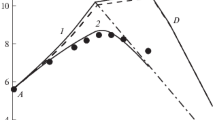Abstract
The limits of explosion of the CF3CFH2–F2–N2, C3F8–F2–N2, C4F8–F2–N2, C4F8–ClF3–N2, C4F10–ClF3–N2, and F2ClCF2Cl–F2–N2 mixtures are determined. For some compositions of the first two mixtures, the maximum pressure of explosion and the maximum pressure‐growth rate are measured. The transition from deflagration to detonation is observed in undiluted mixtures close to stoichiometric compositions. The burning rates of the mixtures examined are comparable with the burning rates of oxygen–hydrogen mixtures.
Similar content being viewed by others
REFERENCES
V. I. Vodyanik, Explosive Protection of Technological Equipment [in Russian], Khimiya, Moscow (1991).
B. Lewis and G. Von Elbe, Combustion, Flames, and Explosions of Gases, Academic Press, New York-London (1961).
A. I. Rozlovskii, Fundamentals of Explosive Safety Engineering in Operating Combustible Gases and Vapors [in Russian], Khimiya, Moscow (1980).
Author information
Authors and Affiliations
Rights and permissions
About this article
Cite this article
Lisochkin, Y.A., Poznyak, V.I. Explosive Hazard of Vapor–Gas Mixtures of Fluoride‐Containing Saturated Hydrocarbons with Fluoride and Chlorine Trifluoride. Combustion, Explosion, and Shock Waves 37, 683–687 (2001). https://doi.org/10.1023/A:1012936332461
Issue Date:
DOI: https://doi.org/10.1023/A:1012936332461




